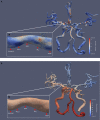Characteristics of Wall Shear Stress and Pressure of Intracranial Atherosclerosis Analyzed by a Computational Fluid Dynamics Model: A Pilot Study
- PMID: 32010041
- PMCID: PMC6978719
- DOI: 10.3389/fneur.2019.01372
Characteristics of Wall Shear Stress and Pressure of Intracranial Atherosclerosis Analyzed by a Computational Fluid Dynamics Model: A Pilot Study
Abstract
Background: Although wall shear stress (WSS) and pressure play important roles in plaque vulnerability, characteristics of the two indices in intracranial atherosclerosis (ICAS) have not been fully investigated yet. This study aimed to elucidate this issue by means of establishing a non-invasive computational fluid dynamics method with time-of-flight magnetic resonance angiography (TOF-MRA) of the whole cerebral artery. Materials and Methods: Subjects with symptomatic ICAS in the middle cerebral artery domain were enrolled, excluding those with concomitant internal carotid artery stenosis. Based on patient-specific TOF-MRA images for three-dimensional (3D) meshes and arterial blood pressure with patient-specific carotid artery ultrasonography for inlet boundary conditions, patients' three-dimensional hemodynamics were modeled by a finite element method governed by Navier-Stokes equations. Results: Among the 55 atherosclerotic lesions analyzed by this TOF-MRA based computational fluid dynamics model, the maximum WSS (WSSmax) was most frequently detected at the apex points and the upper half of the upstream sections of the lesions, whereas the maximum pressure was most often located at the lower half of the upstream sections. As the percent stenosis increases, the relative value of WSSmax and pressure drop increased with significantly increasing steep beyond 50% stenosis. Moreover, WSSmax was found to linearly correlate with pressure drop in ICAS. Conclusions: This study on ICAS revealed certain trends of longitudinal distribution of WSS and pressure and the influences of percent stenosis on cerebral hemodynamics, as well as the correlations between WSS and pressure drop. It represents a step forward in applying computational flow simulation techniques in studying ICAS and stroke, in a patient-specific manner.
Keywords: cerebral hemodynamics; intracranial atherosclerosis; magnetic resonance angiography; mathematical modeling; pressure; wall shear stress.
Copyright © 2020 Chen, Qin, Liu, Wu, Cheng, Jiang, Liu, Jing, Leng, Jing, Wang and Wang.
Figures




Similar articles
-
Hemodynamic parameters distribution of upstream, stenosis center, and downstream sides of plaques in carotid artery with different stenosis: a MRI and CFD study.Acta Radiol. 2015 Mar;56(3):347-54. doi: 10.1177/0284185114526713. Epub 2014 Mar 27. Acta Radiol. 2015. PMID: 24676083 Clinical Trial.
-
Hemodynamic vascular biomarkers for initiation of paraclinoid internal carotid artery aneurysms using patient-specific computational fluid dynamic simulation based on magnetic resonance imaging.Neuroradiology. 2018 May;60(5):545-555. doi: 10.1007/s00234-018-2002-8. Epub 2018 Mar 8. Neuroradiology. 2018. PMID: 29520642
-
A preliminary study of relationship among the degree of internal carotid artery stenosis, wall shear stress on MR angiography and 18F-FDG uptake on PET/CT.J Nucl Cardiol. 2022 Apr;29(2):569-577. doi: 10.1007/s12350-020-02300-3. Epub 2020 Aug 2. J Nucl Cardiol. 2022. PMID: 32743752
-
Clinical implications of haemodynamics in symptomatic intracranial atherosclerotic stenosis by computational fluid dynamics modelling: a systematic review.Stroke Vasc Neurol. 2025 Feb 25;10(1):16-24. doi: 10.1136/svn-2024-003202. Stroke Vasc Neurol. 2025. PMID: 38806205 Free PMC article.
-
A comparison of 4D flow MRI-derived wall shear stress with computational fluid dynamics methods for intracranial aneurysms and carotid bifurcations - A review.Magn Reson Imaging. 2018 May;48:62-69. doi: 10.1016/j.mri.2017.12.005. Epub 2017 Dec 6. Magn Reson Imaging. 2018. PMID: 29223732 Review.
Cited by
-
Quantitative Assessment of Changes in Hemodynamics After Obliteration of Large Intracranial Carotid Aneurysms Using Computational Fluid Dynamics.Front Neurol. 2021 Apr 29;12:632066. doi: 10.3389/fneur.2021.632066. eCollection 2021. Front Neurol. 2021. PMID: 33995243 Free PMC article.
-
Gene Network Mechanism of Zhilong Huoxue Tongyu Capsule in Treating Cerebral Ischemia-Reperfusion.Front Pharmacol. 2022 Jul 7;13:912392. doi: 10.3389/fphar.2022.912392. eCollection 2022. Front Pharmacol. 2022. PMID: 35873563 Free PMC article.
-
A Combined Computational Fluid Dynamics and Arterial Spin Labeling MRI Modeling Strategy to Quantify Patient-Specific Cerebral Hemodynamics in Cerebrovascular Occlusive Disease.Front Bioeng Biotechnol. 2021 Aug 17;9:722445. doi: 10.3389/fbioe.2021.722445. eCollection 2021. Front Bioeng Biotechnol. 2021. PMID: 34485260 Free PMC article.
-
Sub-satisfactory recanalization of severe middle cerebral artery stenoses can significantly improve hemodynamics.Front Cardiovasc Med. 2022 Sep 29;9:922616. doi: 10.3389/fcvm.2022.922616. eCollection 2022. Front Cardiovasc Med. 2022. PMID: 36247480 Free PMC article.
-
Hemodynamic Changes in the Carotid Artery after Infusion of Normal Saline Using Computational Fluid Dynamics.Diagnostics (Basel). 2020 Jul 12;10(7):473. doi: 10.3390/diagnostics10070473. Diagnostics (Basel). 2020. PMID: 32664658 Free PMC article.
References
-
- Chimowitz M, Lynn M, Howlett-Smith H, Stern BJ, Hertzberg VS, Frankel MR, et al. Warfarin-Aspirin Symptomatic intracranial disease trial investigators. Comparison of warfarin and aspirin for symptomatic intracranial arterial stenosis. N Engl J Med. (2005) 352:1305–16. 10.1056/NEJMoa043033 - DOI - PubMed
LinkOut - more resources
Full Text Sources
Medical
Research Materials
Miscellaneous

